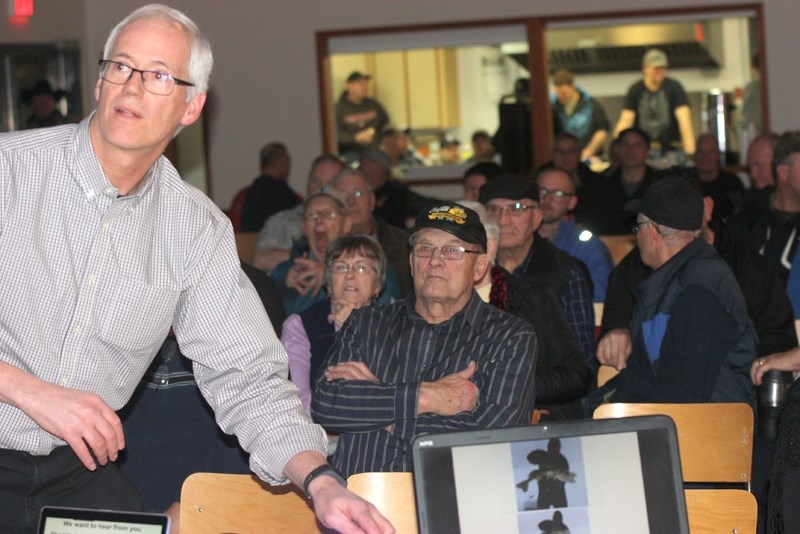Over 150 anglers attended a Jan. 16 meeting at Lac Bellevue Hall to hear the Alberta government’s proposed changes to fishing regulations for 2018, specifically as they apply to walleye and pike.
Travis Ripley, executive director of Fish and Wildlife Policy for Alberta Environment & Parks, and Paul MacMahon, resource director for the Lower Athabasca Region were in attendance for the three-hour meeting.
A similar meeting was held at Lac Bellevue Hall on Sept. 7, 2016, which got a little heated. Emcee Ray Danyluk spoke to the past meeting as soon as the Jan. 16 meeting began.
“We did a lot of venting in our last meeting. It got emotional, but it needed to be. We were in what I call a mode of emotion. (Tonight) we have to be in a mode of selection,” Danyluk said, noting they had the “right people” in the room to have their voices heard, in regards to Ripley and MacMahon.
“I think everyone here wants one thing, to maintain fish stocks in the communities,” Danyluk told the crowd.
Some of the proposed changes for walleye show eight lakes (Minnow, Sylvan, Wabamum, Arnisk, Ethel, Hilda, Round, Gregoire) that are currently catch and release remain as such, move to tags, or move to anglers keeping one walleye greater than 50cm. The overall findings and proposed changes show the walleye population has improved over the years.
Fish population was a heated topic during the 2016 meeting.
Some of the proposed changes for pike include six lakes (Elinor, Ethel, Hilda, Lac La Biche, Fawcett, Nipisi), where anglers can currently keep either one or three pike they catch, move to catch and release or tags.
In total, 34 lakes for 2018 had proposed changes and an additional 46 lakes for 2019 were identified.
Ripley said the proposed changes were based on feedback from a public online survey that was available for those interested to complete.
“It’s (important) for us to hear recommendations from people in this room, as well as (gather information) through the online survey, so that when we are evaluating the options . . . We make the best science-based decisions that we can.”
MacMahon says the framework of the proposal for pike and walleye management is “spread over three years,” from 2018 through 2020. He added that Alberta lakes face extra challenges compared to other lakes out east, which is taken into consideration when putting the proposal together. Items to consider include an increase in anglers, and the environment itself.
“We’re pretty much at the most Northern extent of walleye population in North America, so we don’t have as productive lakes as (other provinces and states). It’s relatively cold, fairly short seasons, it takes a long time for a walleye to grow,” said MacMahon.
“What a walleye might grow in size in six years (elsewhere) it’s going to take double that or even three times (as long) up here in Alberta,” he explained.
Preference selection sheets were handed out at the door while people entered the hall on Tuesday, and results from those sheets, plus a show of hands, indicated the entire room did not support a catch and release only solution for either pike or walleye, nor did all but three attendees support draws for tags for pike or walleye.
During the slideshow, MacMahon explained the process of how the government collected data regarding walleye and pike population in a specific lake, and from that system was able to estimate the approximate number of fish of those species in a lake.
The attendees widely disputed the system used by the government, and one speaker from the crowd suggested after the floor was opened for questions and comments bringing in ‘outsiders’ to conduct an independent study and compare results from the government’s findings, which was supported by others in the room.
The crowd also disagreed with part of the presentation’s reporting a five per cent mortality rate among the walleye population as being far too low. Another show of hands saw everyone in attendance shoot their hand in the air when asked by emcee Danyluk if they think it is much higher.
Following the meeting, Ray Makowecki, a fish biologist and volunteer, sent out an emailed update, offering what he thought were some of the highlights from Tuesday’s meeting.
“For the walleye-pike lakes, the majority of people in attendance said they preferred to have one fish daily harvests of slot-sized walleye and pike that would be controlled by season length (short seasons for lakes smaller than 1,000 hectares), and concurrent (same days or weeks) seasons,” he wrote. “For the pike-perch lakes the majority of people preferred to have one or two pike daily harvests any size or with slot-size restrictions in a few lakes.”
Makowecki noted that simply stated – “All the people attending wanted to eat a fish,” but they also want to see an ecological balance for all fish species.
Restoring lost fish habitats at lakes such as Muriel, Mann Lakes, Bonnie, and more, along with creating new fish habitats, was also brought up. Accuracy of catch and release mortality rates was also discussed, along with anglers wanting to see a reduction in fish mortalities caused by sampling.
Both MacMahon and Ripley reiterated towards the end of the session that these proposed changes are exactly that – proposed. And the government will consider the solutions offered by the group before making any permanent changes.



